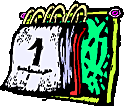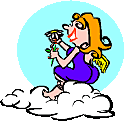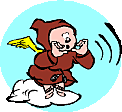Rabboisai,
I am pleased to launch a new column for you, my talmidim. Many have asked, have begged, have pleaded for the opportunity to hear Toirah on additional topics, not just the Parshas Hashavua, because, after all, you get some of your best nap time during Kriyas HaTatorah, the reading of the Toirah.
Well, to meet your needs, I have decided to introduce "Ask Rabbi Pinky," a forum of discussion for you, my beloved minuval students. Since most of you were good-for-nothings growing up who never paid attention in class, I will take time out of my unbelievably busy schedule and use my distinct Rabbinic knowledge, my superior intellect, and my exquisite insights, to provide the wisdom of Chazzal to your actual, ignorant questions, you vilda chayas.
This column's question comes from Rachel L.:
"Rabbi, I have been deluged with questions from my non-Jewish friends about whether or not there is any truth to the "hole in the sheet" thing. What's the deal? Thanks."
Well, meideleh,
First of all, there is no such thing as a "non-Jewish friend." There are only two kinds of goyim -- anti-Semites, and anti-Semites who haven't yet discovered their true natures. And if any of your goyisha "friends" is a man, Ruchulah, please let me assure that he is only after your Bisulta.
In any case, I am both shocked and delighted by your shailah, a question which must come up once a day in my Bais Medrish, and which arises at least once a night in my bedroom when my Bashert isn't in Nidah, chass v'sholom. Indeed, I have done a significant amount of research on this topic, especially in my youth.
I will attempt to answer your shailah by providing both a historical context and halachah lemaiseh, a practical religious ruling, not that you will follow it anyway. You are probably eating skittles or a cheeseburger from McDonalds, chass v'sholom, as you read this, you vilda chaya.
The Toirah itself is silent on this topic. However, there is a medrish in Beraishis Rabbah that suggests that the reason Yankif Avinu didn't recognize that Leah Imainu had been surreptitiously substituted for Rachel, her younger sister, on their wedding night, is that, though they were in a nuptual tent together, Leah's face was out of Yankif's range of eyesight. And, the medrish continues, at the angle at which Yankif saw Leah's feet sticking out from "under the sheet" throughout the entire wedding night, it could easily have been Rachel, or Lavan's grandmother, for that matter, in the tent with him. Please remember: before Matan Toirah, the giving of the Toirah, there were certain practices that a woman would do for her husband that unfortunately, in our day, I cannot get my Bashert to do no matter how much I beg, Rachmana Letzlan.
The first direct reference in Chazzal to using a cloth with a hole comes from the era of Reb Hai Goyn. The Hai Goyn, discussing the holiness of his students at the Yeshiva in Pumpedisa, mentions that one talmid was so righteous, he spent all day and night in the Bais Medrish, but was mekayim the mitzvah of Pru Urvu with his wife during the Shmoineh Esrai of Mairiv through a hole in the mechitza, putting his intense shuckling to good use.
Several hundred years later, the RAMBAN, in his commentary on the Toirah, suggests that Yoiseph Hatzaddik could have saved many a dry cleaning bill for his Coat of Many Colors had he only used a sheet with a hole in it while being mezaneh with his many hot Canaanite girlfriends, "as is the custom in our day," according to the RAMBAN, referring to 13th century Spain.
The MAHARAL MiPrague, writing in the 16th century, suggested in his responsa, rabbinic rulings on contemporary questions, that Jews in his day who are concerned about anti-Semitism, the potential for global self-destruction, and the high cost of Yeshiva tuition are allowed to employ "a linen sheath with a hole in it's center" as a form of birth control. The MAHARAL, of course, is known as one of the greatest pranksters in Jewish history.
It is clear, therefore, from the writings of the RAMBAN and the MAHARAL, that both the Ashkenazic and the Sephardic worlds were familiar with the practice of using a sheet with a hole. However, the actual rationale behind the custom is not at all clear.
A Maiseh Shehoya. It is told of the Chofetz Chaim that once, while visiting a shtetl near minsk, the great sage stayed for Shabbos with a family of Jewish farmers. In the middle of the night, the Chofetz Chaim heard a series of strange mooing-like sounds. Curious, he descended the staircase, exited the house and entered the barn.There he saw the minuval teenage son of the Baal Habayis completely covered in a sheet, save for a single part of his anatomy, which was being tended to by a young calf, if you know what I mean. The Chofetz Chaim is reported to have looked up to Hakkadoshbaruchhu and chastised Him for having created cows that do not "guard their tongue".
In our day, there is a halachic debate as to the applicability of the use of a sheet with a hole. According to the Chassam Soifer, men are encouraged to use a sheet with a hole as a sign of humility before the Aimishteh, though women don't share that requirement, and may contine to file their nails and speak on the telephone while being mekayaim the mitzva of Pru Urvu.
However, Reb Moshe holds farkert. He says that one is not required to employ a sheet with a hole if one is having relations with his attractive wife or a hot shiksa. However, if one is married to a 300 pound battle axe with a face that looks like gefilte fish and a shaytl that looks like roadkill, using a sheet with a hole is a Mitzvah Dioraisa, a biblical requirement.
Ah gutten Shabbos, you minuval.





